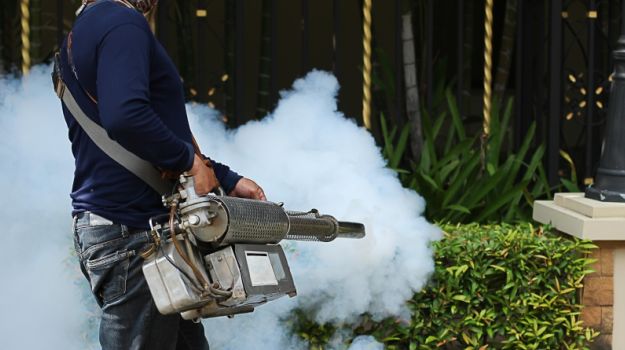The fogging drive carried out by the Delhi government is ineffective against mosquitoes which are responsible for causing the dengue outbreak. After a large number of dengue cases in August this year, government authorities had stepped up fogging as one of the solutions to prevent dengue from spreading. With 12,531 reported cases and 32 deaths as on October 17 in Delhi, including some from adjoining areas, dengue outbreak has been the highest in the last several years. The rise in cases from 778 in August to 6,775 in September and 4,925 by mid-October alone indicates the negligible effect of fogging.“We looked into the issue when community members approached us and shared their observations and experiences. We found that fogging is ineffective in containing dengue and has a harmful effect on the health of people,” said Chandra Bhushan, deputy director general, CSE.Fogging knocks down only the adult mosquito, and not the larvae that are the source of breeding. Larvicide measures, on the other hand, are recognised as an important intervention to prevent large-scale spread of dengue. Targeting adult mosquitoes offers temporary control and that, too, in limited settings and under ideal conditions.
For example, in the case of outdoor fogging the mist most often does not attain the required concentration and reach in order to be to be effective. Pre-conditions like wind speed and direction as well as air temperature influence the concentration. Indoor fogging, on the other hand, is a challenge due to reluctance of residents/owners in allowing fogging into their premise. Besides the limitation of resources, there are practical limitations in covering all houses/premises across the city.The frequency of fogging is another determinant. It is recommended to be repeated after 3-4 days which is far from the reality across the city.“Unless repeated frequently, fogging cannot control the next batch of adults out of the larvae. This is why, source control through larvicide measures is considered effective,” said Amit Khurana, head of Food Safety and Toxins Programme at CSE.The WHO guidelines on dengue, too, question the role of fogging. It recognises that fogging has been used by south-east Asian countries for the past 25 years, but it has not been effective. Even the experts at municipal corporations of Delhi feel that fogging is more about assuring people that some action is being taken.Health and environmental impact of dieselFogging mix usually contains huge amounts of diesel to the tune of 95% along with an insecticide, mostly Malathion. At times petrol is also added. This means a vehicle-mounted container typically has 95 liters of diesel which is used up in one round of fogging. Several rounds by the vehicle in a day could mean several hundred litres of diesel per vehicle.The municipal corporations of south and east Delhi have already spent about Rs 70 lakh on diesel for fogging till Oct 10, 2015. Considering the total area of Delhi, the remaining days of the fogging season and the price of diesel, the estimated total diesel use could go over 4.5 lakh litres this year. Keeping a 100-day fogging-intensive season, this is about 4,500 litres of diesel per day, which is equivalent to diesel used by over 2,000 cars in a day.Diesel is known to contain carcinogens. Malathion, a class III pesticide is also known as slightly hazardous by the WHO. Once sprayed, this concoction is not only inhaled but is also absorbed in soil and water. In case of fogging the entire emissions take place in very short time in a particular area.Medical experts suggest that direct inhalation of diesel fumes, combined with insecticides, can exacerbate asthma or bronchitis among those with respiratory ailments. Pregnant women, small children and old people are most susceptible to aggravation. Eye specialists also mentioned that diesel fumes can also cause irritation and itching on skin and eyes. Prolonged exposure could lead to temporary swelling of the corneas.Systematic prevention works bestInstead of fogging, the focus should be on long-term preventive measures and creating awareness among people. The role of people is no less important than that of the government authorities.“Fogging only creates a false sense of security among people and diverts attention from preventive action for dengue by the state and community. It is only a way of appeasing people at the cost of their health. The government needs a systematic sanitation drive and emphasis on clean surroundings so that mosquito does not get breeding grounds. The community has a very important role in play in controlling dengue by keeping private premises clean,” said Bhushan.
For example, in the case of outdoor fogging the mist most often does not attain the required concentration and reach in order to be to be effective. Pre-conditions like wind speed and direction as well as air temperature influence the concentration. Indoor fogging, on the other hand, is a challenge due to reluctance of residents/owners in allowing fogging into their premise. Besides the limitation of resources, there are practical limitations in covering all houses/premises across the city.The frequency of fogging is another determinant. It is recommended to be repeated after 3-4 days which is far from the reality across the city.“Unless repeated frequently, fogging cannot control the next batch of adults out of the larvae. This is why, source control through larvicide measures is considered effective,” said Amit Khurana, head of Food Safety and Toxins Programme at CSE.The WHO guidelines on dengue, too, question the role of fogging. It recognises that fogging has been used by south-east Asian countries for the past 25 years, but it has not been effective. Even the experts at municipal corporations of Delhi feel that fogging is more about assuring people that some action is being taken.Health and environmental impact of dieselFogging mix usually contains huge amounts of diesel to the tune of 95% along with an insecticide, mostly Malathion. At times petrol is also added. This means a vehicle-mounted container typically has 95 liters of diesel which is used up in one round of fogging. Several rounds by the vehicle in a day could mean several hundred litres of diesel per vehicle.The municipal corporations of south and east Delhi have already spent about Rs 70 lakh on diesel for fogging till Oct 10, 2015. Considering the total area of Delhi, the remaining days of the fogging season and the price of diesel, the estimated total diesel use could go over 4.5 lakh litres this year. Keeping a 100-day fogging-intensive season, this is about 4,500 litres of diesel per day, which is equivalent to diesel used by over 2,000 cars in a day.Diesel is known to contain carcinogens. Malathion, a class III pesticide is also known as slightly hazardous by the WHO. Once sprayed, this concoction is not only inhaled but is also absorbed in soil and water. In case of fogging the entire emissions take place in very short time in a particular area.Medical experts suggest that direct inhalation of diesel fumes, combined with insecticides, can exacerbate asthma or bronchitis among those with respiratory ailments. Pregnant women, small children and old people are most susceptible to aggravation. Eye specialists also mentioned that diesel fumes can also cause irritation and itching on skin and eyes. Prolonged exposure could lead to temporary swelling of the corneas.Systematic prevention works bestInstead of fogging, the focus should be on long-term preventive measures and creating awareness among people. The role of people is no less important than that of the government authorities.“Fogging only creates a false sense of security among people and diverts attention from preventive action for dengue by the state and community. It is only a way of appeasing people at the cost of their health. The government needs a systematic sanitation drive and emphasis on clean surroundings so that mosquito does not get breeding grounds. The community has a very important role in play in controlling dengue by keeping private premises clean,” said Bhushan.
Advertisement












